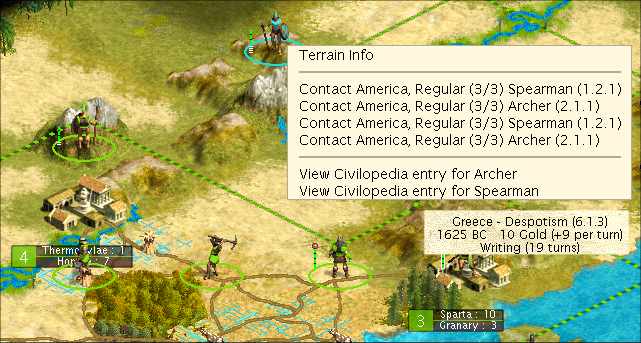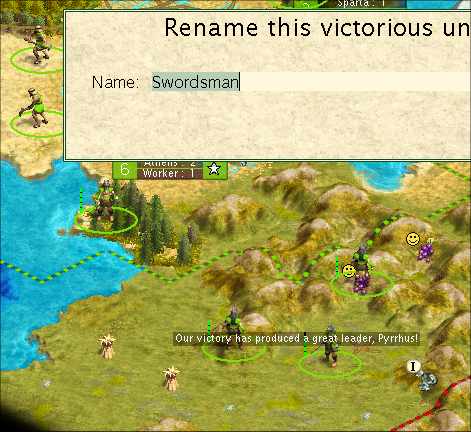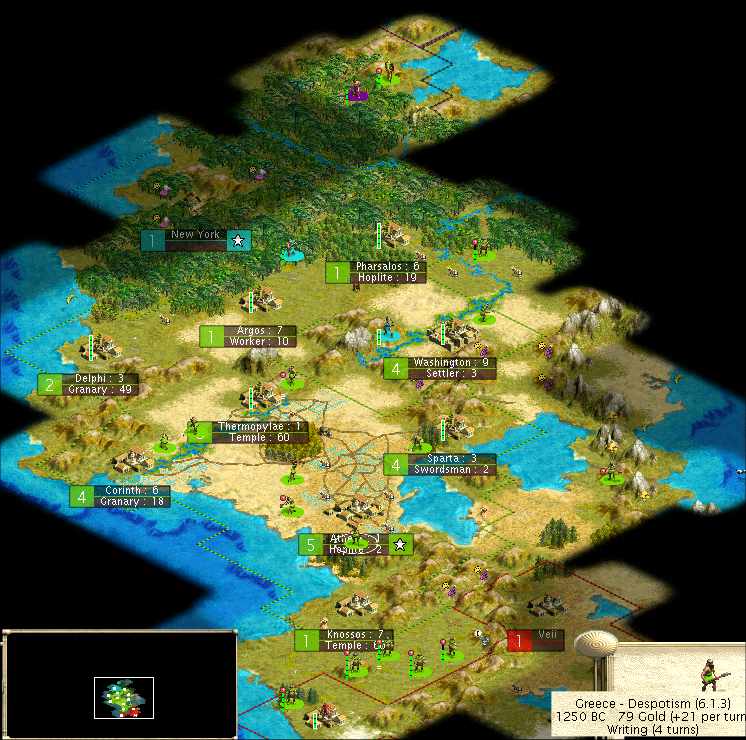I start by moving the worker over to the eastern water to see if it's fresh. Yup, it is, and you can't beat three cattle for a starting position.
Well, yes you can: FIVE cattle!

The worker starts irrigating the cattle, while Athens naturally starts a hoplite. Max research started on Pottery. I'm a huge advocate of ALWAYS building a granary before even your first settler - even in Always War.
In, uh, 3700 BC, America shows up. Well, they're one of the better possible civs to begin right next to. I trade my Alphabet + Bronze Working for their Masonry + Pottery + 10g. I declare war, and start researching Iron Working at max.
After its first hoplite, Athens starts another. I intend to speed up the growth curve quickly even here in Always War; to do that I'm going to build plenty of extra hoplites to be able to stand on squares the worker has worked, protecting them from pillaging.
In 3300 BC, I place this plan into effect, as two American warriors come up to my capital. One hoplite is fortified in the city, another is protecting the improved square, and one is defending the worker while it works. I'm safe - the RNG isn't going to let a warrior beat a hoplite, is it?

Except that that's TWO warriors. T-W-O. One more than one. That's SIX hit points of warrior about to attack my single hoplite in the city. (Hey, do we human players get to respawn if we lose? It was true in Alpha Centauri...)
My thought process went roughly like this: End Turn, I should be okay with hoplites defending against warriors - okay here comes one, is it going to attack the unfortified hoplite or the city? It's the city. Hey, it took one hitpoint off my hoplite - OH CRAP IT TOOK TWO HITPOINTS OFF MY HOPLITE - whew it died I'm okay NO WAIT OH CRAP THAT'S TWO WARRIORS I'M DOOMED but wait my hoplite promoted I HAVE A CHANCE here it comes UH OH hoplite's back down to ONE hp GO GO HOPLITE one more round youcandoit YES IT WON! okay let's restart my heart now.
Score one for Sleepy Gambit. ![]()
Once my blood pressure returned to normal, I clicked on the popup informing me that the Golden Age had started. Oh, right. I don't know how I thought I might've delayed it a bit. It will be almost completely wasted - the cattle squares are already producing two shields and the third is lost to despotism - but it will get to Iron Working a few turns sooner.
In 2900 BC, Athens produces its granary, and starts a settler. I decide to send one hoplite off where the American units had come from to go investigate.

I park the hoplite next to Washington, and America is locked. The city won't ever build a settler now, since the AI will forever whip units to suicide against the hoplite every time it reaches size 2.
And there's also a red border visible down there. I wisely decide not to investigate, but only two turns later a Roman warrior comes into my view. I trade him Masonry for Warrior Code + 14 gold, and declare war. I move a hoplite out of the city to protect the cattle square - after checking five times that it was only one warrior - and the warrior beats itself to death on the hoplite.
Athens builds the settler, which ventures out with a hoplite as Athens builds a replacement. I take about ten minutes to decide where to put the city. It's going to go northeast of Athens, towards America: either on the forest square or on the hill due south of Washington. The forest would let it share three cattle tiles to get maximum use out of them and is a three-square move from Athens for moving defensive units. The hill is better city spacing, on a hill for defense, and is closer to Washington.

I decided on the hill, because that would bring all three other hills within the immediate city radius on the chance that they had iron.
And in 2630, an English scout appears. Hmm, more civs than I had expected to start on the same island. No trades to be made; we have Masonry but they have only 4 gold, and so war is declared.
So with America locked down and my hoplites holding their own against Rome's occasional warrior, I'm free to expand to the northwest, since I haven't seen any other civs coming from that direction. Athens keeps building a mix of settlers, workers, and hoplites. I'm micromanaging the city the whole time to make sure it always has +5 food for growth every two turns.
America actually did send one archer around my hoplite to Sparta. I had planned to whip walls if that happened, but the archer got there before Sparta got to size 2. All I could do was have faith in my veteran fortified hilly hoplite to beat the archer, and it did.
Iron Working finishes, and I eagerly look around for iron. None visible at first, but then a Ctrl-Shift-M shows some RIGHT UNDERNEATH SPARTA! This is a unbelievably lucky break - Sparta isn't hooked up yet by road. Athens can build cheap warriors, and send them to Sparta to upgrade! Just as long as I don't hook up Sparta, which now I won't do for quite a while. Sometimes it's better to be lucky than good.
Athens as the seat of government, and Sparta as the military training camp? Could this be any more accurate a reconstruction of historical Greece? :)

In the picture, Sparta has just whipped a barracks to do the upgrading. Athens had also whipped one (by building 10 shields, whipping a settler, and building the last 10 shields.) Also note more American archers coming towards the city, but I'm getting swords ready just in time. Note the income box there: 33 gold and +7/turn. That adds up to exactly 40, so I can use that money to do a pre-turn swordsman upgrade in Sparta. And Athens just happens to be completing something this turn to give me access to Sparta to do that. :)
I sent out one more settler after Thermopylae, four squares southwest of that city, at the coast on a river. That city was Corinth, which built its own worker (very necessary in the flood plains area), then extra hoplites for defense. After the settlers for those two cities, Athens started alternating producing a worker and a warrior every turn. With +5 food and +10 shields, that's a perfect pattern. It does require continuous micromanagement, though. The micromanagement includes the luxury slider, which is up to 40% most of the time and sometimes even 50%.
I also sent a hoplite south to keep watch on Rome, and to park on their nearby iron.

Now that's what I like to see!
In 1830 BC, a ZULU scout shows up in the east. Man, that's a lot of civs. Are we sure we're on an archipelago? Five civs here? Well, I can trade them Iron Working to get The Wheel, Ceremonial Burial, and 14 gold, and so I do.
Also in 1830 BC, I finally get three veteran swordsmen up next to Washington. (40 gold a pop to upgrade warriors is a lot, even while running minimum science.) One dies, but the other two defeat the two spears, and capture the city gaining three workers (the city had a settler and a worker in it. Why in the world didn't they send out the settler?) I claim Capture (Not Raze) of Enemy City in 1830 BC. America respawns somewhere, of course.
It doesn't take long for them to show up again:

And that's two spears, more than they had before. I lost two swords over time attacking the stack, and eventually one got to the only wines I had connected (at Washington) and pillaged it, forcing me to jack up luxuries as high as 50% for a few turns. The easiest way to replace the wines was to dump a worker colony on one of the wines outside Greek borders. Colonies form instantly, while building a road on a hill takes 6 turns that I didn't have.
I sent a hoplite north to find America's city, and here it is, in the middle of a horrendous jungle:

Also in 1425 BC, I got three swords down to Veii in the south, and that city was autorazed. As swordsmen get produced (mostly from Sparta, some from Athens), I've been sending about one to the south for every two that go north.
Meanwhile, I'm still micromanaging at Athens, producing lots of settlers and the occasional sword (I connected the Sparta road after capturing Washington to get the wines connected. You can see it in the 1625 BC picture.) The settlers venture out with hoplites, and my empire is growing. In 1325 BC, one of those pairs met ANOTHER civilization: India! They have nothing to trade us, so we just declare war. I can only hope I'm finally done meeting more civs on this island. (Note that I haven't gotten Writing so I wasn't able to see what contacts the other civs had or to trade for any.)

On my very first elite swordsman attack (did have a few elite hoplite defenses and one elite hoplite attack), I get a Great Leader! Well, there's several options: Army, Pyramids, Forbidden Palace, or save for Great Library. Actually, there's one option. It'll still be a while before I have enough cities for the FP; the Great Library is likewise 20-40 turns away, and an army wouldn't be much use now. So the Pyramids it is, which are the first cultural building built by any of the known civs, judging by the histogram.
After a couple more settlers and 36 turns of minimum research on Writing, here's where I stand. I think I've been quite successful in ramping up along the growth curve. It doesn't take much military to completely cripple a Monarch AI, and nobody else is getting anywhere near having iron hooked up for swords, so my own swords dominate the area.

Yes, Athens, Corinth, and Knossos are not garrisoned. The cities are on the back lines (even Knossos; look at the wall of military in front of it), so they aren't in any danger; why not keep the hoplites moving along to where they'll be useful?
(This was immediately after the Pyramids were built; the two cities building granaries switched to something else.)